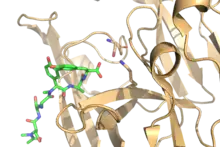Arylomycin
The arylomycins are a class of antibiotics initially isolated from a soil sample obtained in Cape Coast, Ghana.[1] In this initial isolation, two families of closely related arylomycins, A and B, were identified. The family of glycosylated arylomycin C lipopeptides were subsequently isolated from a Streptomyces culture in a screen for inhibitors of bacterial signal peptidase.[2] The initially isolated arylomycins have a limited spectrum of activity against Gram-positive bacteria, including Staphylococcus aureus and Streptococcus pneumoniae. The only activity against Gram-negative bacteria was seen in strains with a compromised outer membrane.[2]



Following their initial identification and characterization, co-crystal structures with the E. coli signal peptidase were determined[3][4] and showed that the core of the arylomycins binds to the signal peptidase with the alanine residue in the macrocyclic ring taking the place of the P3 alanine residue in the signal peptidase Ala-X-Ala recognition motif. Additionally, the C terminus of the arylomycins is seen to be within hydrogen bonding distance of the serine/lysine catalytic dyad.
Intrigued by the possibility that the arylomycins could represent a class of latent antibiotics whose activity is hidden by mutations in the signal peptidase of bacteria otherwise susceptible to them, researchers in the laboratory of Floyd Romesberg, a chemical biologist at the Scripps Research Institute in San Diego, California, developed a total synthesis of these natural products. The first arylomycin synthesized was arylomycin A2,[5] and this was followed by the preparation of the arylomycins B2[6] and C.[7]
Their mechanism of action involves inhibition of bacterial type I signal peptidase (SPase).[8] Because there are currently no pharmaceutical drugs with this type of antibiotic activity, arylomycins may have applications in treating drug-resistant bacterial infections and they have therefore attracted research interest.[9]
Synthetic analogs of arylomycins, such as G0775, have been developed which have broader spectrum activity and greater efficacy.[10]
See also
References
- Schimana, Judith; Gebhardt, Klaus; Höltzel, Alexandra; Schmid, Dietmar G.; Süssmuth, Roderich; Müller, Johannes; Pukall, Rüdiger; Fiedler, Hans-Peter (June 2002). "Arylomycins A and B, new biaryl-bridged lipopeptide antibiotics produced by Streptomyces sp. Tü 6075. I. Taxonomy, fermentation, isolation and biological activities". The Journal of Antibiotics. 55 (6): 565–570. doi:10.7164/antibiotics.55.565. ISSN 0021-8820. PMID 12195962.
- Kulanthaivel, Palaniappan; Kreuzman, Adam J.; Strege, Mark A.; Belvo, Matthew D.; Smitka, Tim A.; Clemens, Matthew; Swartling, James R.; Minton, Kristina L.; Zheng, Feng (2004-08-27). "Novel Lipoglycopeptides as Inhibitors of Bacterial Signal Peptidase I". Journal of Biological Chemistry. 279 (35): 36250–36258. doi:10.1074/jbc.M405884200. ISSN 0021-9258. PMID 15173160.
- Paetzel, Mark; Goodall, Jonathon J.; Kania, Malgosia; Dalbey, Ross E.; Page, Malcolm G. P. (2004-07-16). "Crystallographic and Biophysical Analysis of a Bacterial Signal Peptidase in Complex with a Lipopeptide-based Inhibitor". Journal of Biological Chemistry. 279 (29): 30781–30790. doi:10.1074/jbc.M401686200. ISSN 0021-9258. PMID 15136583.
- Luo, Chuanyun; Roussel, Patrick; Dreier, Jürg; Page, Malcolm G.P.; Paetzel, Mark (2009-09-29). "Crystallographic Analysis of Bacterial Signal Peptidase in Ternary Complex with Arylomycin A2and a β-Sultam Inhibitor". Biochemistry. 48 (38): 8976–8984. doi:10.1021/bi9009538. ISSN 0006-2960. PMID 19655811.
- Roberts, Tucker C.; Smith, Peter A.; Cirz, Ryan T.; Romesberg, Floyd E. (December 2007). "Structural and Initial Biological Analysis of Synthetic Arylomycin A2". Journal of the American Chemical Society. 129 (51): 15830–15838. doi:10.1021/ja073340u. ISSN 0002-7863. PMID 18052061.
- Dufour, Jeremy; Neuville, Luc; Zhu, Jieping (2010-07-23). "Intramolecular Suzuki-Miyaura Reaction for the Total Synthesis of Signal Peptidase Inhibitors, Arylomycins A2 and B2". Chemistry - A European Journal. 16 (34): 10523–10534. doi:10.1002/chem.201000924. ISSN 0947-6539. PMID 20658499.
- Liu, Jian; Luo, Chuanyun; Smith, Peter A.; Chin, Jodie K.; Page, Malcolm G. P.; Paetzel, Mark; Romesberg, Floyd E. (2011-11-09). "Synthesis and Characterization of the Arylomycin Lipoglycopeptide Antibiotics and the Crystallographic Analysis of Their Complex with Signal Peptidase". Journal of the American Chemical Society. 133 (44): 17869–17877. doi:10.1021/ja207318n. ISSN 0002-7863. PMC 3277211. PMID 21999324.
- Smith, Peter A; Romesberg, Floyd E (2012). "Mechanism of Action of the Arylomycin Antibiotics and Effects of Signal Peptidase I Inhibition". Antimicrobial Agents and Chemotherapy. 56 (10): 5054–5060. doi:10.1128/AAC.00785-12. PMC 3457390. PMID 22802255.
- Andy Extance (September 13, 2018). "Genentech antibiotic quells resistance". Chemistry World.
- Smith PA, Koehler MT, Girgis HS, Yan D, Chen Y, Chen Y, et al. (September 2018). "Optimized arylomycins are a new class of Gram-negative antibiotics". Nature. 561 (7722): 189–194. doi:10.1038/s41586-018-0483-6. PMID 30209367.